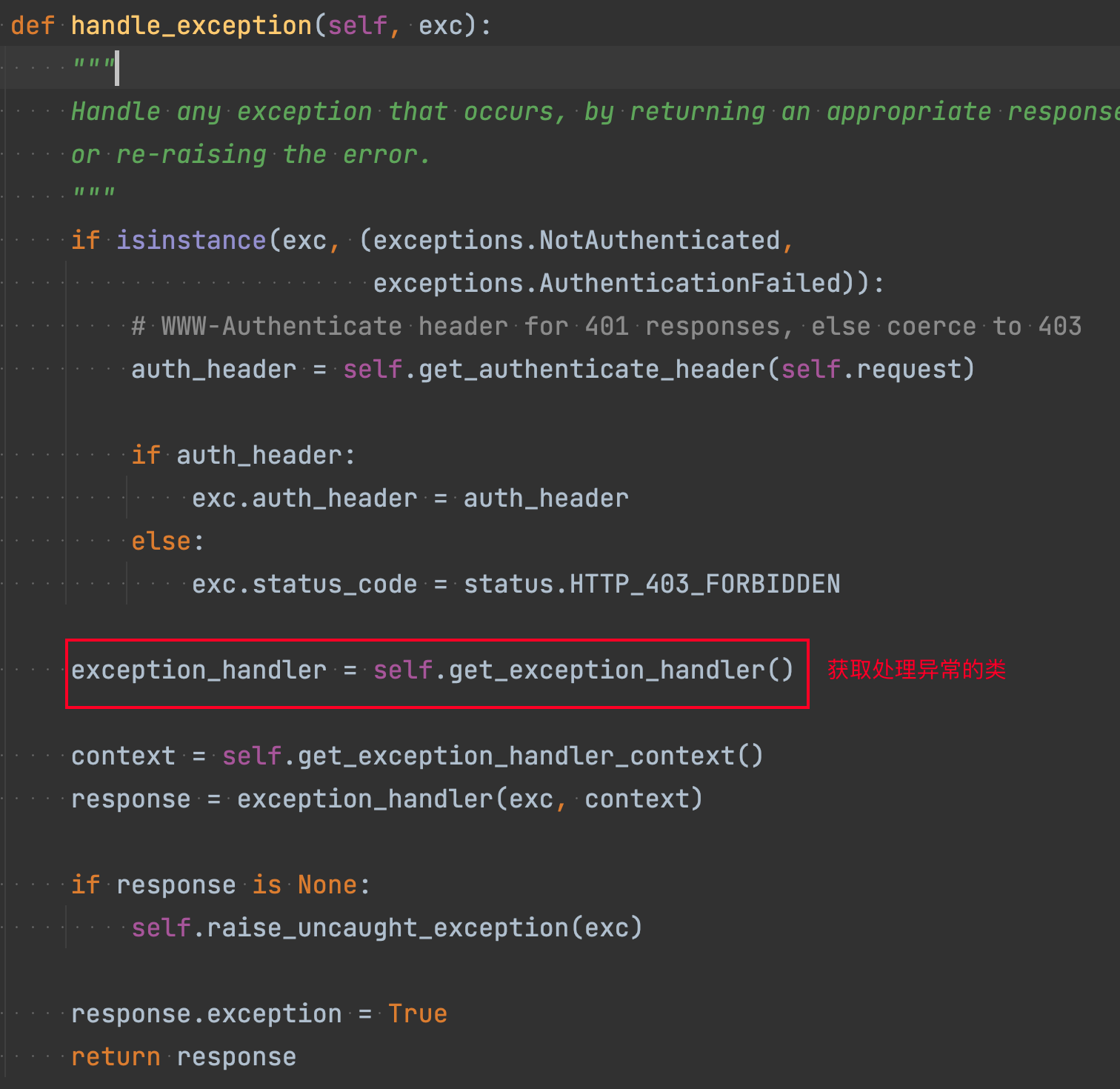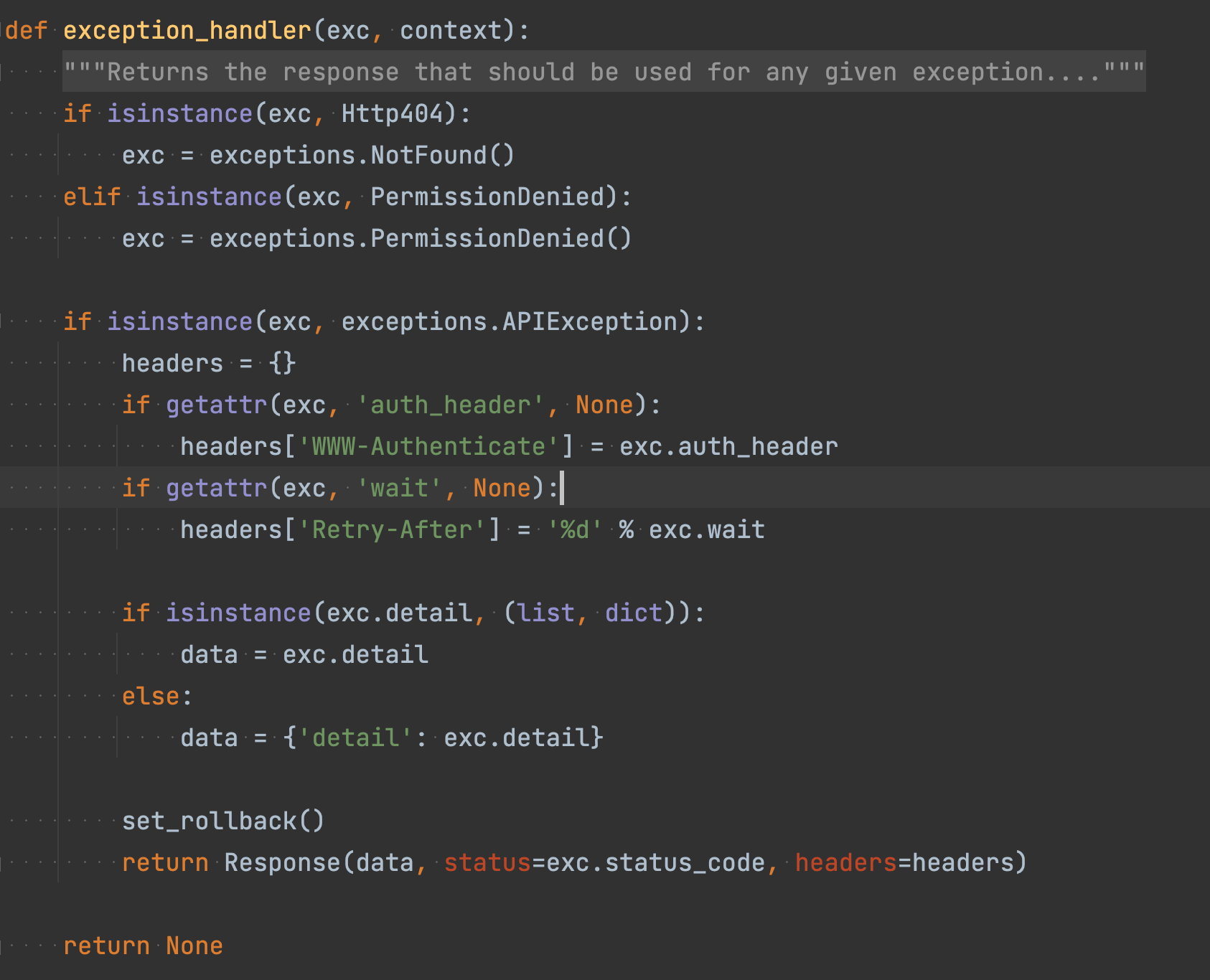django中的返回值可以分为:
- 异常返回值
- 正常返回值
1. Djanog中常见的异常返回值有如下
- 序列化校验错误
12345{"age": ["A valid integer is required."]} - 数据不存在
http://127.0.0.1:8000/api/demon/11/
123{"detail":"Not found."} - 认证错误
123{"detail":"Incorrect authentication credentials."} - 权限错误
123{"detail":"Authentication credentials were not provided."} - 限流错误
123{"detail":"Request was throttled"} - 其他错误:python的语法错误等
2.异常处理源码分析
上面的这些错误都会在dispath函数中进行捕获和处理



最后通过配置文件可以找到处理异常的函数


这个函数就是对常见的异常进行捕获处理,并且这个函数只能处理基于APIException的类,对于python法人语法错误是无法捕获的,只能继续上报,导致程序报错
3. 自定义异常处理方法
为此我们可以自定义该类如下
1 2 3 4 5 6 7 8 9 10 11 12 13 14 15 16 17 18 19 20 21 22 23 24 25 26 27 28 29 30 31 32 33 34 35 36 37 38 39 40 41 42 43 44 45 46 47 48 49 50 51 52 53 54 | # encoding:utf-8# author:kunmzhao# email:1102669474@qq.comfrom django.core.exceptions import PermissionDeniedfrom django.http import Http404from rest_framework import exceptions, statusfrom rest_framework.response import Responsefrom rest_framework.views import set_rollbackfrom rest_framework.exceptions import AuthenticationFailed, NotAuthenticated, Throttled, ValidationErrordef exception_handler(exc, context): """ Returns the response that should be used for any given exception. By default we handle the REST framework `APIException`, and also Django's built-in `Http404` and `PermissionDenied` exceptions. Any unhandled exceptions may return `None`, which will cause a 500 error to be raised. """ if isinstance(exc, Http404): exc = exceptions.NotFound() exc.ret_code = 1001 elif isinstance(exc, PermissionDenied): exc = exceptions.PermissionDenied() exc.ret_code = 1002 elif isinstance(exc, (AuthenticationFailed, NotAuthenticated)): exc.ret_code = 1003 elif isinstance(exc, Throttled): exc.ret_code = 1004 elif isinstance(exc, ValidationError): exc.ret_code = 1005 headers = {} if getattr(exc, 'auth_header', None): headers['WWW-Authenticate'] = exc.auth_header if getattr(exc, 'wait', None): headers['Retry-After'] = '%d' % exc.wait code = getattr(exc, "ret_code", -1) if isinstance(exc, exceptions.APIException): detail = exc.detail else: detail = "请求错误" print(detail) if isinstance(detail, (list, dict)): data = {"code": code, 'error': detail} else: data = {"code": code, 'error': detail} set_rollback() return Response(data, headers=headers) |
配置如下
1 2 3 | REST_FRAMEWORK = { 'EXCEPTION_HANDLER': 'utils.exception_handler',} |
以后我们也可以自定义一些异常,放入该函数中,对异常进行分类,便于前端根据异常ma进行处理
4.正常返回值源码分析

我们可以重写该方法,返回我们需要的数据格式,如下
1 2 3 4 5 6 7 8 9 10 11 12 13 | class DemonView(ModelViewSet): queryset = models.Student.objects.all() serializer_class = DemonDModelSerializers # authentication_classes = [DemonAuthentication, ] # permission_classes = [DemonPermission, ] # throttle_classes = [DemonThrottle, ] def finalize_response(self, request, response, *args, **kwargs): super().finalize_response(request, response, *args, **kwargs) if not response.exception: // 对于异常的response不做处理 response.data = {"code": 0, "data": response.data} return response |
通过以上的方式就可以很好的自定义我们返回的数据格式了!!!


【推荐】国内首个AI IDE,深度理解中文开发场景,立即下载体验Trae
【推荐】编程新体验,更懂你的AI,立即体验豆包MarsCode编程助手
【推荐】抖音旗下AI助手豆包,你的智能百科全书,全免费不限次数
【推荐】轻量又高性能的 SSH 工具 IShell:AI 加持,快人一步
· 被坑几百块钱后,我竟然真的恢复了删除的微信聊天记录!
· 没有Manus邀请码?试试免邀请码的MGX或者开源的OpenManus吧
· 【自荐】一款简洁、开源的在线白板工具 Drawnix
· 园子的第一款AI主题卫衣上架——"HELLO! HOW CAN I ASSIST YOU TODAY
· Docker 太简单,K8s 太复杂?w7panel 让容器管理更轻松!